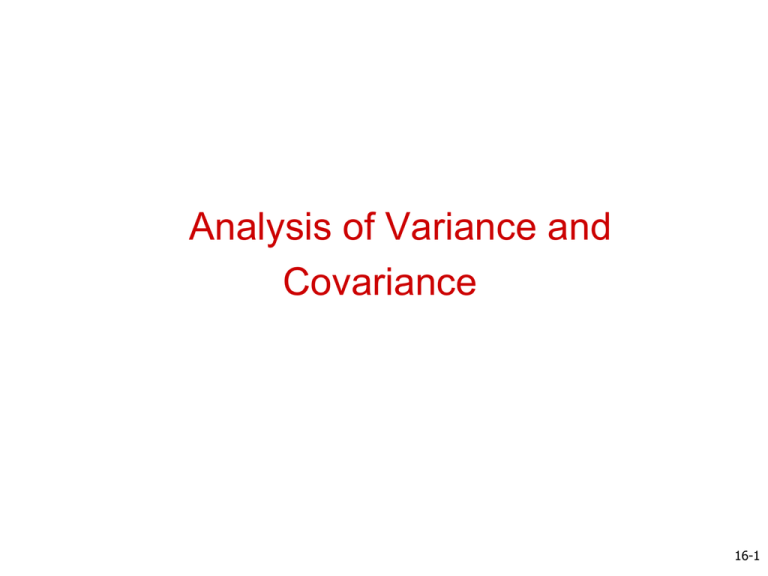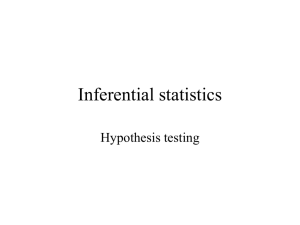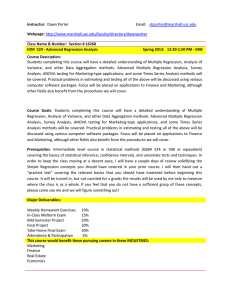Analysis of Variance and Covariance 16-1
advertisement

Analysis of Variance and Covariance 16-1 Chapter Outline 1) Overview 2) Relationship Among Techniques 3) One-Way Analysis of Variance 4) Statistics Associated with One-Way Analysis of Variance 5) Conducting One-Way Analysis of Variance i. Identification of Dependent & Independent Variables ii. Decomposition of the Total Variation iii. Measurement of Effects iv. Significance Testing v. Interpretation of Results Chapter Outline 6) Illustrative Applications of One-Way Analysis of Variance 7) Assumptions in Analysis of Variance 8) N-Way Analysis of Variance 9) Analysis of Covariance 10) Issues in Interpretation i. Interactions ii. Relative Importance of Factors iii. Multiple Comparisons 11) Multivariate Analysis of Variance Relationship Among Techniques • Analysis of variance (ANOVA) is used as a test of means for two or more populations. The null hypothesis, typically, is that all means are equal. • Analysis of variance must have a dependent variable that is metric (measured using an interval or ratio scale). • There must also be one or more independent variables that are all categorical (nonmetric). Categorical independent variables are also called factors. Relationship Among Techniques • A particular combination of factor levels, or categories, is called a treatment. • One-way analysis of variance involves only one categorical variable, or a single factor. Here a treatment is the same as a factor level. • If two or more factors are involved, the analysis is termed n-way analysis of variance. • If the set of independent variables consists of both categorical and metric variables, the technique is called analysis of covariance (ANCOVA). • The metric-independent variables are referred to as covariates. Relationship Amongst Test, Analysis of Variance, Analysis of Covariance, & Regression Fig. 16.1 Metric Dependent Variable OneIndep Independent One Variable One or More One or more Indep Var Binary Categorical: Factorial Categorical and Interval Interval t Test Analysis of Variance Analysis of Covariance Regression One Factor More than One Factor One-Way Analysis of Variance N-Way Analysis of Variance One-Way Analysis of Variance Marketing researchers are often interested in examining the differences in the mean values of the dependent variable for several categories of a single independent variable or factor. For example: • Do the various segments differ in terms of their volume of product consumption? • Do the brand evaluations of groups exposed to different commercials vary? • What is the effect of consumers' familiarity with the store (measured as high, medium, and low) on preference for the store? Statistics Associated with One-Way Analysis of Variance • F statistic. The null hypothesis that the category means are equal is tested by an F statistic. • The F statistic is based on the ratio of the variance between groups and the variance within groups. • The variances are related to sum of squares Statistics Associated with One-Way Analysis of Variance • SSbetween. Also denoted as SSx , this is the variation in Y related to the variation in the means of the categories of X. This is variation in Y accounted for by X. • SSwithin. Also referred to as SSerror , this is the variation in Y due to the variation within each of the categories of X. This variation is not accounted for by X. • SSy. This is the total variation in Y. Conducting One-Way ANOVA Fig. 16.2 Identify the Dependent and Independent Variables Decompose the Total Variation Measure the Effects Test the Significance Interpret the Results Conducting One-Way ANOVA: Decomposing the Total Variation The total variation in Y may be decomposed as: SSy = SSx + SSerror, where N SS y =S (Y i -Y 2 ) i =1 c SS x =S n (Y j -Y )2 j =1 c SS error=S j n S (Y ij -Y j )2 i Yi = individual observation Y j = mean for category j Y = mean over the whole sample, or grand mean Yij = i th observation in the j th category Conducting One-Way ANOVA : Decomposition of the Total Variation Table 16.1 Within Category Variation =SSwithin Category Mean Independent Variable X1 Y1 Y2 : : Yn Y1 X2 Y1 Y2 Categories X3 … Xc Y1 Y1 Y2 Y2 Yn Y2 Yn Y3 Yn Yc X Total Sample Y1 Y2 : : YN Y Between Category Variation = SSbetween Total Variatio n =SSy Conducting One-Way ANOVA: Measure Effects and Test Significance In one-way analysis of variance, we test the null hypothesis that the category means are equal in the population. H0: µ1 = µ2 = µ3 = ........... = µc The null hypothesis may be tested by the F statistic which is proportional to following ratio: F ~ SS x SS error This statistic follows the F distribution Conducting One-Way ANOVA: Interpret the Results • If the null hypothesis of equal category means is not rejected, then the independent variable does not have a significant effect on the dependent variable. • On the other hand, if the null hypothesis is rejected, then the effect of the independent variable is significant. • A comparison of the category mean values will indicate the nature of the effect of the independent variable. Illustrative Applications of One-Way ANOVA We illustrate the concepts discussed in this chapter using the data presented in Table 16.2. The department store chain is attempting to determine the effect of in-store promotion (X) on sales (Y). The null hypothesis is that the category means are equal: H0: µ1 = µ2 = µ3. Effect of Promotion and Clientele on Sales Table 16.2 Store Num ber 1 2 3 4 5 6 7 8 9 10 11 12 13 14 15 16 17 18 19 20 21 22 23 24 25 26 27 28 29 30 Coupon Level In-Store Prom otion Sales Clientel Rating 1.00 1.00 10.00 9.00 1.00 1.00 9.00 10.00 1.00 1.00 10.00 8.00 1.00 1.00 8.00 4.00 1.00 1.00 9.00 6.00 1.00 2.00 8.00 8.00 1.00 2.00 8.00 4.00 1.00 2.00 7.00 10.00 1.00 2.00 9.00 6.00 1.00 2.00 6.00 9.00 1.00 3.00 5.00 8.00 1.00 3.00 7.00 9.00 1.00 3.00 6.00 6.00 1.00 3.00 4.00 10.00 1.00 3.00 5.00 4.00 2.00 1.00 8.00 10.00 2.00 1.00 9.00 6.00 2.00 1.00 7.00 8.00 2.00 1.00 7.00 4.00 2.00 1.00 6.00 9.00 2.00 2.00 4.00 6.00 2.00 2.00 5.00 8.00 2.00 2.00 5.00 10.00 2.00 2.00 6.00 4.00 2.00 2.00 4.00 9.00 2.00 3.00 2.00 4.00 2.00 3.00 3.00 6.00 2.00 3.00 2.00 10.00 2.00 3.00 1.00 9.00 2.00 3.00 2.00 8.00 One-Way ANOVA: Effect of In-store Promotion on Store Sales Table 16.4 Source of Variation Sum of squares df Mean square F ratio F prob Between groups (Promotion) Within groups (Error) TOTAL 106.067 2 53.033 17.944 0.000 79.800 27 2.956 185.867 29 6.409 Cell means Level of Promotion High (1) Medium (2) Low (3) Count Mean 10 10 10 8.300 6.200 3.700 TOTAL 30 6.067 Assumptions in Analysis of Variance 1. The error term is normally distributed, with a zero mean 2. The error term has a constant variance. 3. The error is not related to any of the categories of X. 4. The error terms are uncorrelated. N-Way Analysis of Variance In marketing research, one is often concerned with the effect of more than one factor simultaneously. For example: • How do advertising levels (high, medium, and low) interact with price levels (high, medium, and low) to influence a brand's sale? • Do educational levels (less than high school, high school graduate, some college, and college graduate) and age (less than 35, 35-55, more than 55) affect consumption of a brand? • What is the effect of consumers' familiarity with a department store (high, medium, and low) and store image (positive, neutral, and negative) on preference for the store? N-Way Analysis of Variance • Consider two factors X1 and X2 having categories c1 and c2. • The significance of the overall effect is tested by an F test • If the overall effect is significant, the next step is to examine the significance of the interaction effect. This is also tested using an F test • The significance of the main effect of each factor may be tested using an F test as well Two-way Analysis of Variance Table 16.5 Source of Variation Main Effects Promotion Coupon Combined Two-way interaction Model Residual (error) TOTAL Sum of squares df Mean square F Sig. of F 106.067 53.333 159.400 3.267 2 1 3 2 53.033 53.333 53.133 1.633 54.862 55.172 54.966 1.690 0.000 0.000 0.000 0.226 162.667 5 23.200 24 185.867 29 32.533 0.967 6.409 33.655 0.000 2 0.557 0.280 Two-way Analysis of Variance Table 16.5, cont. Cell Means Promotion High High Medium Medium Low Low TOTAL Coupon Yes No Yes No Yes No Count 5 5 5 5 5 5 Mean 9.200 7.400 7.600 4.800 5.400 2.000 30 Factor Level Means Promotion High Medium Low Coupon Yes No Grand Mean Count 10 10 10 15 15 30 Mean 8.300 6.200 3.700 7.400 4.733 6.067 Analysis of Covariance • When examining the differences in the mean values of the dependent variable, it is often necessary to take into account the influence of uncontrolled independent variables. For example: • In determining how different groups exposed to different commercials evaluate a brand, it may be necessary to control for prior knowledge. • In determining how different price levels will affect a household's cereal consumption, it may be essential to take household size into account. • Suppose that we wanted to determine the effect of in-store promotion and couponing on sales while controlling for the affect of clientele. The results are shown in Table 16.6. Analysis of Covariance Table 16.6 Sum of Source of Variation Mean Sig. Squares df Square F of F 0.838 1 0.838 0.862 0.363 106.067 2 53.033 54.546 0.000 53.333 1 53.333 54.855 0.000 159.400 3 53.133 54.649 0.000 3.267 2 1.633 1.680 0.208 163.505 6 27.251 28.028 0.000 Covariance Clientele Main effects Promotion Coupon Combined 2-Way Interaction Promotion* Coupon Model Residual (Error) TOTAL Covariate Clientele 22.362 23 0.972 185.867 29 6.409 Raw Coefficient -0.078 Issues in Interpretation Important issues involved in the interpretation of ANOVA results include interactions, relative importance of factors, and multiple comparisons. Interactions • The different interactions that can arise when conducting ANOVA on two or more factors are shown in Figure 16.3. Relative Importance of Factors • It is important to determine the relative importance of each factor in explaining the variation in the dependent variable. A Classification of Interaction Effects Fig. 16.3 Possible Interaction Effects No Interaction (Case 1) Interaction Ordinal (Case 2) Disordinal Noncrossover (Case 3) Crossover (Case 4) Patterns of Interaction Fig. 16.4 Case 1: No Interaction X 22 X Y 21 X 11 X 12 Case 2: Ordinal Interaction X 22 Y X X 13 Case 3: Disordinal Interaction: Noncrossover X 22 Y X 21 21 X X X 11 12 13 Case 4: Disordinal Interaction: Crossover X 22 Y X 21 X 11 X 12 X 13 X 11 X 12 X 13 Multivariate Analysis of Variance • Multivariate analysis of variance (MANOVA) is similar to analysis of variance (ANOVA), except that instead of one metric dependent variable, we have two or more. • In MANOVA, the null hypothesis is that the vectors of means on multiple dependent variables are equal across groups. • Multivariate analysis of variance is appropriate when there are two or more dependent variables that are correlated. Regression Analysis © 2007 Prentice Hall 17-29 Chapter Outline 1) Correlations 2) Bivariate Regression 3) Statistics Associated with Bivariate Regression 4) Conducting Bivariate Regression Analysis i. Scatter Diagram ii. Bivariate Regression Model iii. Estimation of Parameters iv. Standardized Regression Coefficient v. Significance Testing © 2007 Prentice Hall 17-30 Chapter Outline vi. Strength and Significance of Association vii. Assumptions 5) Multiple Regression 6) Statistics Associated with Multiple Regression 7) Conducting Multiple Regression i. ii. iii. Partial Regression Coefficients Strength of Association Significance Testing 8) Multicollinearity 9) Relative Importance of Predictors © 2007 Prentice Hall 17-31 Product Moment Correlation • The product moment correlation, r, summarizes the strength of association between two metric (interval or ratio scaled) variables, say X and Y. • It is an index used to determine whether a linear or straight-line relationship exists between X and Y. • r varies between -1.0 and +1.0. • The correlation coefficient between two variables will be the same regardless of their underlying units of measurement. © 2007 Prentice Hall 17-32 Explaining Attitude Toward the City of Residence Table 17.1 Respondent No Attitude Toward the City Duration of Residence Importance Attached to Weather 1 6 10 3 2 9 12 11 3 8 12 4 4 3 4 1 5 10 12 11 6 4 6 1 7 5 8 7 8 2 2 4 9 11 18 8 10 9 9 10 11 10 17 8 2 2 5 © 2007 Prentice Hall 12 17-33 Product Moment Correlation • When it is computed for a population rather than a sample, the product moment correlation is denoted by r , the Greek letter rho. The coefficient r is an estimator of r. • The statistical significance of the relationship between two variables measured by using r can be conveniently tested. The hypotheses are: H0 : r = 0 H1 : r 0 © 2007 Prentice Hall 17-34 Significance of correlation •The test statistic has a t dist. •The r bet. ‘Attitude towards city’ and ‘Duration’ is 0.9361 • The value of t-stat is 8.414. •From the t table (Table 4 in the Stat Appdx), the critical value of t for a two-tailed test and a = 0.05 is 2.228. •Hence, the null hypothesis of no relationship between X and Y is rejected © 2007 Prentice Hall 17-35 Regression Analysis Regression analysis examines associative relationships between a metric dependent variable and one or more independent variables in the following ways: • Determine whether the independent variables explain a significant variation in the dependent variable: whether a relationship exists. • Determine how much of the variation in the dependent variable can be explained by the independent variables: strength of the relationship. • Predict the values of the dependent variable. © 2007 Prentice Hall 17-36 Statistics Associated with Bivariate Regression Analysis • Regression model. Yi = b 0+ b 1Xi + ei whereY = dep var, X = indep var, b 0 = intercept of the line, b1 = slope of the line, and ei is the error term for the i th observation. • Coefficient of determination: r 2. Measures strength of association. Varies bet. 0 and 1 and signifies proportion of the variation in Y accounted for by the variation in X. • Estimated or predicted value of Yi is Yi = a + bx where Y i is the predicted value of Yi and a and b are estimators of b 0 and b 1 © 2007 Prentice Hall 17-37 Statistics Associated with Bivariate Regression Analysis • Regression coefficient. The estimated parameter b is usually referred to as the nonstandardized regression coefficient. • Standard error of estimate. This statistic is the standard deviation of the actual Y values from the predicted Y values. • Standard error. The standard deviation of b, SEb is called the standard error. © 2007 Prentice Hall 17-38 Statistics Associated with Bivariate Regression Analysis • Sum of squared errors. The distances of all the points from the regression line are squared and added together to arrive at the sum of squared errors, which is a measure of total error, Se 2. j • t statistic. A t statistic can be used to test the null hypothesis that no linear relationship exists between X and Y © 2007 Prentice Hall 17-39 Idea Behind Estimating Regression Eqn • A scatter diagram, or scattergram, is a plot of the values of two variables • The most commonly used technique for fitting a straight line to a scattergram is the least-squares procedure. • In fitting the line, the least-squares procedure minimizes the sum of squared errors, Se j2 . © 2007 Prentice Hall 17-40 Conducting Bivariate Regression Analysis Plot the Scatter Diagram Formulate the General Model Estimate the Parameters Estimate Regression Coefficients Test for Significance Determine the Strength and Significance of Association © 2007 Prentice Hall 17-41 Plot of Attitude with Duration Fig. 17.3 Attitude 9 6 3 2.25 4.5 6.75 9 11.25 13.5 15.75 18 Duration of Residence © 2007 Prentice Hall 17-42 Which Straight Line Is Best? Fig. 17.4 Line 1 Line 2 9 Line 3 Line 4 6 3 2.25 4.5 © 2007 Prentice Hall 6.75 9 11.25 13.5 15.75 18 17-43 Decomposing the Total Variation Fig. 17.6 Y Residual Variation (SSRes ) Explained Variation (SSReg ) Y X1 © 2007 Prentice Hall X2 X3 X4 X5 X 17-44 Decomposing the Total Variation The total variation, SSy, may be decomposed into the variation accounted for by the regression line, SSreg, and the error or residual variation, SSerror or SSres, as follows: SSy = SSreg + SSres where n SSy = iS=1 (Yi - Y)2 n SSreg = iS (Yi - Y)2 =1 n SSres = iS= (Yi - Yi)2 1 © 2007 Prentice Hall 17-45 Strength and Significance of Association The strength of association is: 2 R = SS re g SS y Answers the question: ”What percentage of total variation in Y is explained by X?” © 2007 Prentice Hall 17-46 Test for Significance The statistical significance of the linear relationship between X and Y may be tested by examining the hypotheses: H0 : b 1 = 0 H1 : b 1 0 A t statistic can be used, where t=b/SEb SEb denotes the standard deviation of b and is called the standard error. © 2007 Prentice Hall 17-47 Illustration of Bivariate Regression The regression of attitude on duration of residence, using the data shown in Table 17.1, yielded the results shown in Table 17.2. a= 1.0793, b= 0.5897. The estimated equation is: Attitude ( ) = 1.0793 + 0.5897 (Duration of residence) Y The standard error, or standard deviation of b is 0.07008, and t = 0.5897/0.0700 =8.414. The p-value corresponding to the calculated t is 0.000. Since this is smaller than a=0.05, the null hypothesis is rejected. © 2007 Prentice Hall 17-48 Bivariate Regression Table 17.2 Multiple R R2 Adjusted R2 Standard Error 0.93608 0.87624 0.86387 1.22329 df Regression Residual F = 70.80266 Variable Duration (Constant) © 2007 Prentice Hall 1 10 ANALYSIS OF VARIANCE Sum of Squares Mean Square 105.95222 105.95222 14.96444 1.49644 Significance of F = 0.0000 VARIABLES IN THE EQUATION b SEb Beta (ß) T 0.58972 0.07008 1.07932 0.74335 0.93608 Significance of T 8.414 0.0000 1.452 0.1772 17-49 Strength and Significance of Association • The predicted values ( Y) can be calculated using Attitude ( Y) = 1.0793 + 0.5897 (Duration of residence) • For the first observation in Table 17.1, this value is: Y = 1.0793 + 0.5897 x 10 = 6.9763. • For each observation, we can obtain this value • Using these, SSreg =105.9524, SSres =14.9644 R2=105.95/(105.95+14.96)=0.8762, © 2007 Prentice Hall 17-50 Strength and Significance of Association Another, equivalent test for examining the significance of the linear relationship between X and Y (significance of b) is the test for the significance of the coefficient of determination. The hypotheses in this case are: H0: R2pop = 0 H1: R2pop > 0 © 2007 Prentice Hall 17-51 Strength and Significance of Association • The appropriate test statistic is the F statistic which has an F distribution. • The p-value corresponding to the F statistic is: 0.0000 Therefore, the relationship is significant at the α=0.05 level, corroborating the results of the t test. © 2007 Prentice Hall 17-52 Assumptions • The error term is normally distributed. • The mean of the error term is 0. • The variance of the error term is constant. This variance does not depend on the values assumed by X. • The error terms are uncorrelated. In other words, the observations have been drawn independently. © 2007 Prentice Hall 17-53 Multiple Regression The general form of the multiple regression model is as follows: Y = b 0 + b 1 X1 + b 2 X2 + b 3 X3+ . . . + b k Xk + e which is estimated by the following equation: Y = a + b1X1 + b2X2 + b3X3+ . . . + bkXk As before, the coefficient a represents the intercept, but the b's are now the partial regression coefficients. © 2007 Prentice Hall 17-54 Stats Associated with Multiple Reg • Coefficient of multiple determination. The strength of association is measured by R2. • Adjusted R2. R2, coefficient of multiple determination, is adjusted for the number of independent variables and the sample size. • F test. The F test is used to test the null hypothesis that the coefficient of multiple determination in the population, R2pop, is zero. The test statistic has an F distribution © 2007 Prentice Hall 17-55 The Multiple Regression Equation • For data in Table 17.1, suppose we want to explain ‘Attitude Towards City’ by ‘Duration’ and ‘Importance of Weather’ • From Table 17.3, the estimated regression equation is: ( Y) = 0.33732 + 0.48108 X1 + 0.28865 X2 or Attitude = 0.33732 + 0.48108 (Duration) + 0.28865 (Importance) © 2007 Prentice Hall 17-56 Multiple Regression Table 17.3 Multiple R R2 Adjusted R2 Standard Error 0.97210 0.94498 0.93276 0.85974 df Regression Residual F = 77.29364 Variable IMPORTANCE DURATION © 2007 Prentice Hall (Constant) 2 9 ANALYSIS OF VARIANCE Sum of Squares Mean Square 114.26425 57.13213 6.65241 0.73916 Significance of F = 0.0000 VARIABLES IN THE EQUATION b SEb Beta (ß) T 0.28865 0.08608 0.48108 0.05895 0.33732 0.56736 0.31382 0.76363 Significance of T 3.353 0.0085 8.160 0.0000 17-57 0.595 0.5668 Strength of Association The strength of association is measured by R2, which is similar to bivariate case R2 is adjusted for the number of independent variables and the sample size. It is called Adjusted R2 © 2007 Prentice Hall 17-58 Conducting Multiple Regression Analysis: Significance Testing H0 : R2pop = 0, This is equivalent to the following null hypothesis: H0: b 1 = b 2 = b 3 = . . . = b k = 0 The overall test (for all βi’s collectively) can be conducted by using an F statistic which has an F distribution. Testing for the significance of the individual βi’s can be done in a manner similar to that in the bivariate case by using t tests © 2007 Prentice Hall 17-59 Multicollinearity • Multicollinearity arises when intercorrelations among the predictors are very high. • Multicollinearity can result in several problems, including: – The partial regression coefficients may not be estimated precisely. The standard errors are likely to be high. It becomes difficult to assess the relative importance of the independent variables in explaining the variation in the dependent variable. © 2007 Prentice Hall 17-60 – Relative Importance of Predictors • Statistical significance. If the partial regression coefficient of a variable is not significant, that variable is judged to be unimportant. • Measures based on standardized coefficients or beta weights. The most commonly used measures are the absolute values of the beta weights, |Bi| , or the squared values, Bi 2. © 2007 Prentice Hall 17-61


